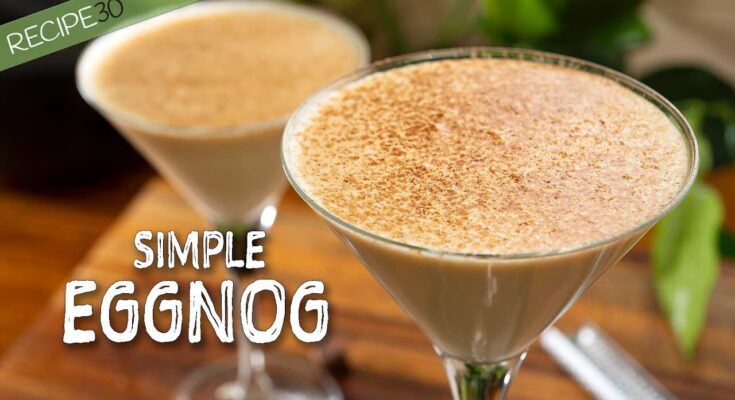Eggnog Recipe: The holidays wouldn’t feel complete without a glass of creamy eggnog. But if you’ve only had store-bought versions, you’re missing out! Making eggnog at home is not only easy but also gives you the freedom to customize it exactly how you like. Whether you enjoy it spiked with rum or prefer it kid-friendly, this guide will walk you through every step to make the perfect batch.
Eggnog has long been a tradition during Christmas and New Year’s gatherings. It’s rich, decadent, and full of festive spices like nutmeg and cinnamon.
So, ready to learn how to make the best eggnog? Let’s dive in!
Ingredients for Homemade Eggnog
You’ll need a handful of basic ingredients to get started:
- 6 large eggs
- ¾ cup sugar (adjust based on your sweetness preference)
- 2 cups whole milk
- 1 cup heavy cream
- ½ teaspoon ground nutmeg
- ½ teaspoon ground cinnamon
- 1 teaspoon vanilla extract
- Alcohol (optional): ¾ cup rum, bourbon, or brandy
Optional add-ins: Whipped cream for topping or a dash of cocoa powder for extra flavor.
Tools You’ll Need
- Large mixing bowls
- Hand or stand mixer
- Whisk
- Saucepan (if cooking the eggnog)
- Ladle or pitcher for serving
How to Make Traditional Eggnog at Home (Step-by-Step)
Step 1: Separate the Eggs
Carefully separate the egg yolks from the whites. Place the yolks in one bowl and the whites in another. Make sure there’s no yolk in the whites; otherwise, they won’t whip properly.
Step 2: Whisk the Egg Yolks with Sugar
Whisk the yolks until they become thick and pale yellow. Gradually add the sugar and continue whisking until it’s fully dissolved and smooth. This step creates the base for your eggnog’s creamy texture.
Step 3: Add Milk, Cream, and Spices
Pour in the milk and heavy cream, followed by nutmeg, cinnamon, and vanilla extract. Whisk until everything is well combined.
Step 4: Cook the Mixture Slowly (Optional)
If you prefer a cooked eggnog for safety, transfer the mixture to a saucepan and heat over medium-low heat. Stir continuously until it reaches 160°F (71°C). Avoid boiling, as that can cause curdling.
Step 5: Whip Egg Whites and Fold In
Using a hand or stand mixer, whip the egg whites until they form soft peaks. Gently fold them into the cooled eggnog mixture. This step adds a fluffy texture to the drink.
Step 6: Add Alcohol (If Desired)
For those who want to spike their eggnog, now is the time to stir in your preferred spirit, such as rum or bourbon.
Step 7: Chill and Serve
Refrigerate the eggnog for at least an hour to allow the flavors to meld. When ready to serve, give it a good stir and ladle it into glasses.
Cooking vs. Non-Cooking Method: Which One is Better?
- Raw Eggnog: Faster to make and more traditional, but carries a small risk of salmonella.
- Cooked Eggnog: Safer to consume, especially for children and pregnant women, but requires extra time and attention.
Variations of Eggnog Recipes
- Dairy-Free or Vegan Eggnog: Use almond milk, oat milk, or coconut milk with silken tofu or aquafaba for texture.
- Alcohol-Free Eggnog for Kids: Omit the alcohol and add extra vanilla or a hint of orange zest for flavor.
- Spiced Eggnog: Add cloves, ginger, or star anise for a bold, spicy kick.
How to Serve Eggnog Like a Pro
Top each glass with a sprinkle of nutmeg or cinnamon. For an extra indulgent touch, add a dollop of whipped cream. Serve it chilled or slightly warm, depending on your preference.
Storing Eggnog Safely
Homemade eggnog can be stored in the refrigerator for up to 3 days. Keep it in an airtight container to maintain freshness.
Health Considerations
Eggnog is rich in calories, so enjoy it in moderation. You can lighten it up by using low-fat milk and cutting back on sugar.
History of Eggnog
Eggnog is believed to have originated in Europe and was brought to the American colonies, where it became a holiday favorite. Early versions were known as “posset,” a hot drink made with milk, eggs, and ale.
Common Mistakes to Avoid When Making Eggnog
- Curdling: Avoid overheating the mixture when cooking eggnog.
- Over-Whipping: Be careful not to overbeat the egg whites, as this can make the drink too airy.
Can You Make Eggnog Ahead of Time?
Yes! In fact, letting eggnog sit in the fridge for a day allows the flavors to develop beautifully.
Eggnog with a Twist: Experimenting with Different Spirits
Try experimenting with other spirits like brandy or amaretto to change up the flavor.
Pairing Eggnog with Snacks and Desserts
Eggnog pairs perfectly with cookies, gingerbread, or fruitcake—ideal for any holiday gathering!
FAQs about Eggnog Recipe
What ingredients are needed for a traditional eggnog recipe?
A classic eggnog recipe typically includes eggs, sugar, milk, cream, and a splash of vanilla extract. For those who enjoy a bit of holiday spirit, adding rum, brandy, or bourbon is common.
How long does homemade eggnog last?
Homemade eggnog can be stored in the refrigerator for about 3-5 days. Make sure it’s kept in a sealed container and consumed within this timeframe to maintain its freshness and safety.
Is it safe to use raw eggs in eggnog?
Using raw eggs in eggnog can pose a risk of salmonella infection. To make it safer, you can use pasteurized eggs or cook the eggnog gently to an internal temperature of 160°F (71°C) to kill any potentially harmful bacteria.
Can eggnog be made dairy-free?
Absolutely! For a dairy-free version, substitute the milk and cream with almond milk, coconut milk, or any other plant-based milk of your choice. This variation is also great for those who are lactose intolerant.
What are some ways to flavor eggnog?
Traditional eggnog is flavored with nutmeg, but you can also add cinnamon or allspice for a different twist. For a more festive touch, some like to add a bit of orange zest or swap the vanilla extract for almond extract.
Can eggnog be served hot?
Yes, eggnog can be served warmed, which is especially comforting during the colder months. Heat it slowly on the stove, but be careful not to let it boil to avoid curdling the eggs.
Is there a quick way to thicken eggnog?
For a thicker consistency, some recipes recommend adding a little cornstarch or cooking the eggnog on low heat until it reaches the desired thickness. Alternatively, whisking in a bit more cream can also do the trick.
Conclusion
Making homemade eggnog is easier than you might think. Whether you enjoy it plain or spiked, it’s the perfect way to celebrate the holiday season. So, gather your ingredients, follow the steps, and impress your friends and family with this festive treat!
References
For those looking to deepen their understanding of eggnog and explore a variety of recipes, the following references are highly recommended. These sources are well-regarded in the culinary world and provide comprehensive insights into the preparation of this festive beverage.
- Epicurious – Offers a classic take on the traditional eggnog recipe along with user reviews that can help you adjust the recipe to your taste.
- AllRecipes – Features a diverse collection of eggnog recipes, including both alcoholic and non-alcoholic versions, complete with detailed instructions and community feedback.
- Serious Eats – Provides a thorough exploration of the history of eggnog, including expert tips on how to achieve the perfect texture and flavor balance.
- Food Network – Hosts several eggnog recipes from renowned chefs, giving readers the chance to try gourmet versions of this beloved holiday drink.
- The Spruce Eats – Offers detailed guidance on making eggnog from scratch, including variations to suit different dietary needs and preferences.
These resources not only enhance your cooking experience but also ensure that the information you rely on is accurate and reliable. Whether you’re a novice or a seasoned cook, these references will help you master the art of making delicious eggnog.



